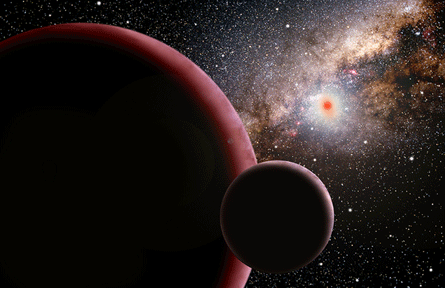With nearly 300 planets now known beyond the solar system, astronomers are honing their hunting skills, trying to determine which stars are most likely to harbor planets that resemble Earth. A four-year study of 400 stars, most of them similar to the sun, have yielded what astronomers are calling a “remarkable” and unprecedented statistic.

As many as 30 percent of sunlike stars possess close-in, relatively small planets — only four to 30 times as heavy as Earth. These are small enough to have a solid, rocky surface like Earth’s or an icy one like Neptune’s. The planets all lie near their parent star and take less than 50 days to complete an orbit.
Christophe Lovis of Geneva Observatory in Switzerland and his colleagues base their findings on a search for tiny wobbles, induced by the tug of small, unseen planets, in the motion of several hundred F, G and K stars. Such stars range from 0.7 to 1.2 times the mass of the sun. (The sun is a G type star.) The researchers measured the wobbles, indicated by periodic shifts in the wavelength of starlight, using a sensitive spectrometer called HARPS, for High Accuracy Radial velocity Planetary Search, on the European Southern Observatory’s 3.6-meter telescope in La Silla, Chile.
Lovis and his collaborators found signs of 45 low-mass planets among a subset of the stars. These include at least eight superEarths — objects that are likely to have rocky surfaces and have between about four and 10 times Earth’s mass. Heavier objects, up to 30 times Earth’s mass, are classified as ice giants or Neptune-like planets, which would have an icy surface and an atmosphere composed mainly of hydrogen and helium.
Lovis presented the findings May 20 in Cambridge, Mass., at an International Astronomical Union conference on extrasolar planets.
At this point, most of the 45 orbs are only candidate planets because their existence has to be confirmed by further spectroscopic study, Lovis emphasizes. None of the putative planets would be habitable because they lie too close to the blistering heat of their parent star.
Because the findings are still tentative, Lovis declined to provide the location or names of the stars. However, veteran planet hunter Michel Mayor of Geneva Observatory is expected to officially announce the discovery of three of these objects, all superEarths orbiting the same star, in mid-June at a meeting in Nantes, France on extrasolar planets. The announcement will be the first time researchers have detected such a low-mass trio around a single star.
The notion that 30 percent of all sunlike stars have close-in superEarths or superNeptunes is “really remarkable,” comments theorist Sara Seager of MIT. “That’s a huge number,” she says.
Researchers, she notes, had previously found that about 10 percent of sunlike stars have hot Jupiters—behemoths that orbit their stars at distances much closer than Mercury, the solar system’s innermost planet, orbits the sun. Putting that number together with the estimate from Lovis’ team, “that means that 40 percent of sunlike stars have planetary systems very different from our own,” Seager notes. “And that is sobering.”







